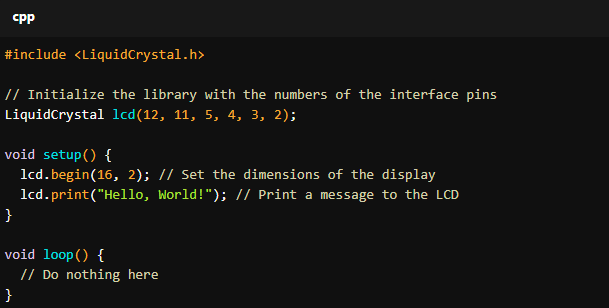In the realm of electronic displays, the 16x2 COG LCD display stands out as a versatile and efficient option for a variety of applications. Whether you’re designing a new product or upgrading an existing one, understanding the features and benefits of this display technology is crucial. This guide will provide insights into the 16x2 COG LCD display, its functionality, advantages, and common use cases.
What is a 16x2 COG LCD Display?
A 16x2 COG (Chip-On-Glass) LCD display consists of 16 columns and 2 rows of characters, allowing it to display up to 32 alphanumeric characters at once. The COG technology integrates the LCD driver directly onto the glass substrate, resulting in a compact and lightweight design. This display type is commonly used in embedded systems, consumer electronics, and industrial applications.
Key Features of 16x2 COG LCD Displays
Compact Size
The COG design minimizes the space required for the display, making it ideal for projects where space is limited.
Low Power Consumption
These displays are energy-efficient, which is crucial for battery-operated devices.
Wide Viewing Angle
They typically offer good visibility from various angles, enhancing user experience.
Easy Integration
The 16x2 COG LCD can be easily interfaced with microcontrollers and development boards, such as Arduino and Raspberry Pi.
Durability
COG displays are robust and can withstand various environmental conditions, making them suitable for industrial use.
Benefits of Using 16x2 COG LCD Displays
1. Cost-Effective Solution
The 16x2 COG LCD display is an economical choice for many projects. Its low production costs, combined with its reliability, make it a popular option for manufacturers looking to balance quality and cost.
2. Readability
With clear characters and a simple layout, the 16x2 format is easy to read, even in low-light conditions. This makes it suitable for applications where quick information retrieval is essential.
3. Versatility
These displays are versatile and can be used in a variety of applications, from home appliances to automotive dashboards. They are particularly favored in user interfaces that require straightforward textual information.
4. Customizability
Manufacturers can easily customize the display's backlight color, font size, and other characteristics to fit specific needs, enhancing the overall design of the product.
Common Applications of 16x2 COG LCD Displays
1. Consumer Electronics
You will often find 16x2 COG LCD displays in devices like microwaves, washing machines, and other home appliances where user interaction is required.
2. Industrial Equipment
In factory settings, these displays are used in control panels, instrumentation, and machinery interfaces, providing essential information to operators.
3. Medical Devices
The clear readability and compact design make them suitable for medical equipment, such as patient monitors and diagnostic tools.
4. Automotive Displays
Many vehicles use 16x2 displays for dashboards and infotainment systems, allowing drivers to quickly access important information.
5. DIY Projects
Hobbyists and developers frequently use these displays in Arduino and Raspberry Pi projects, thanks to their ease of integration and availability.
How to Interface a 16x2 COG LCD Display with Arduino
Required Components
- 16x2 COG LCD Display
- Arduino Board (e.g., Arduino Uno)
- Breadboard and jumper wires
- 10kΩ potentiometer (for contrast adjustment)
Wiring Diagram
- Connect the display's VSS pin to GND.
- Connect the VDD pin to +5V.
- Connect the VO pin to the middle pin of the potentiometer (other two pins to VDD and GND).
- Connect the RS pin to a digital pin (e.g., D12).
- Connect the RW pin to GND.
- Connect the E pin to another digital pin (e.g., D11).
- Finally, connect the data pins (D0 to D7) to digital pins on the Arduino.
Sample Code
Here's a basic example to get you started:
 Frequently Asked Questions (FAQs)
Frequently Asked Questions (FAQs)
Q: What is the difference between COG and other LCD technologies?
A: COG displays integrate the LCD driver onto the glass, making them more compact and lightweight compared to traditional LCDs.
Q: Can I use a 16x2 COG LCD display with other microcontrollers?
A: Yes, these displays can be used with various microcontrollers, including Raspberry Pi and ESP8266, with the appropriate libraries and interfaces.
Q: How do I adjust the contrast of the display?
A: The contrast can usually be adjusted using a potentiometer connected to the VO pin of the display.
Q: Are there color options for the backlight?
A: Yes, many 16x2 COG LCD displays come with customizable backlight options, including blue, green, and white.
The 16x2 COG LCD display is a powerful and adaptable choice for a wide range of applications. Its compact size, low power consumption, and ease of integration make it a preferred option among engineers and hobbyists alike. Whether you are designing a consumer product, an industrial application, or a DIY project, this display technology offers numerous advantages that can enhance functionality and user experience.
If you are considering a project that requires a reliable display solution, the 16x2 COG LCD display should be at the top of your list. For any further questions or assistance, feel free to reach out to a display technology expert.
